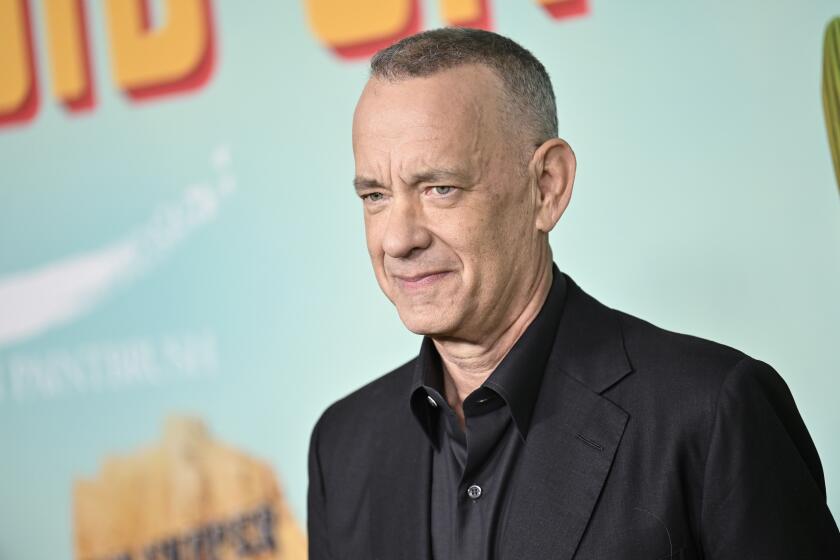Review: Clint Eastwood and Tom Hanks team up to tell the tale of a stoic, heroic ‘Sully’
Several factors might have drawn Clint Eastwood to directing “Sully,” the story of 2009’s “Miracle on the Hudson” emergency landing of a US Airways passenger jet on that frigid New York river, but one that’s not the most obvious might be the most significant.
“Sully” stars Tom Hanks as Capt. Chesley “Sully” Sullenberger III, who on Jan. 15 of that year artfully deposited his ailing Airbus A320 and its 155 passenger and crew on the water with zero loss of life and became a national hero in the process.
Efficient and effective in Eastwood’s experienced hands, “Sully” has interwoven a crisp and electric retelling of the story of the landing we know with a story we do not, a version of what happened behind the scenes when the National Transportation Safety Board investigated whether, miraculous results notwithstanding, the option the pilot chose was the best one.
But, more than that, as played by Hanks and described by Todd Komarnicki’s script, Sullenberger sounds an awful lot like Eastwood himself: a maverick who goes his own way. Someone who didn’t consult algorithms in making his landing decision but, with a lifetime of flying to back him up, went with his gut instead.
When the pilot defends his decision by saying “I eyeballed it” and dares anyone to argue, when he says of himself, “I’m just a man doing his job,” this film takes on an element of Eastwood, no doubt unintentionally, describing himself, taking the opportunity to put his own artistic credo up on the screen. The link is so strong that it’s not hard to imagine a younger Eastwood playing Sully as well as directing.
Saying that takes nothing away from Hanks, who, judging from the real Sullenberger footage that plays during the closing credits, has captured something of the pilot’s unaffectedly heroic mien in addition to his gray-haired appearance.
Hanks has always been especially good at characters with innate decency, and Sullenberger’s concern for the safety of his passengers, each and every one, is something the actor quite convincingly conveys.
When the film with his name on it begins, however, Sully is in a different mood altogether. Though he has flown thousands of flights and uncounted passengers over 42 years in the air, he’s never had an experience like this.
It’s the first day after the catastrophe, and though the New York media are beside themselves, as only the New York media can be, with toasting his “frankly astounding” feat, the man has other things on his mind.
For one thing, though the film never names it as such, the harrowing nature of what he went through seems to have given Sully a case of post-traumatic stress disorder, leading to sleeplessness, nightmares (including a recurring one of crashing into a Manhattan skyscraper), and fragmentary conversations with his distraught wife, Lorrie, (an underused Laura Linney) besieged by the media back home in California.
And, the film posits, worse is yet to come, as Sully has to face the ordeal of a National Transportation Safety Board investigation into his actions, life-saving though they were. (In the film, the public hearings on the flight take place just days after the crash; in real life, it was 18 months later.)
“Why are they looking for something wrong?” copilot Jeff Skiles (Aaron Eckhart) asks after an intense NTSB grilling, though both Sully and his US Airways colleagues know the answer: A very expensive plane is dead and useless in the Hudson River, something neither the airline nor its insurance carrier is happy about.
As the film suggests, the NTSB did use flight simulators to see if the plane could have made it back to LaGuardia Airport and found that in some circumstances it might have been possible. But though in the service of drama the film presents an almost adversarial NTSB, news reports at the time indicate that the board, nervous about being seen as second-guessing a hero, in fact downplayed the flight simulator results.
What “Sully” and Eastwood’s pared-down style are best at is the intense re-creation of what Sully insists is a “forced water landing,” not a crash, as well as the tense evacuation of the passengers and crew as icy water (the temperature outside was 36 degrees, the wind-chill minus five) slowly invades the cabin.
Though it does take some time introducing us to a few of Flight 1549’s passengers — for instance, a feisty grandmother and a father and two grown sons headed for a golfing vacation — the kind of small talk involved is not this film’s strength.
Rather, as is frequently the case with Eastwood’s work, the picture is at its best detailing what went down during the crash (sorry Sully) and the professionalism of the crew both then and during the hazardous, emotional aftermath.
“Sully” returns to the specifics of the Jan. 15 event again and again, memorably presenting it from several different angles and points of view and at different moments in the experience.
Eastwood and his longtime cinematographer Tom Stern chose to shoot “Sully” largely with an IMAX Arri Alexa 65 (with a Red camera for aerial work) and the results offer both detailed and memorable imagery, with the shot of the plane knifing through the Hudson like a 70-ton Olympic swimmer sure to linger in the memory. Sully is shown at one point worrying whether he will be labeled “a hero or a fraud,” but the film with his name on it leaves you no such doubts.
===
MPAA rating: PG-13 for some peril and brief strong language.
Running time: 1 hour, 35 minutes.
In general release.
See the most-read stories in Entertainment this hour »
Movie Trailers
More to Read
Only good movies
Get the Indie Focus newsletter, Mark Olsen's weekly guide to the world of cinema.
You may occasionally receive promotional content from the Los Angeles Times.











